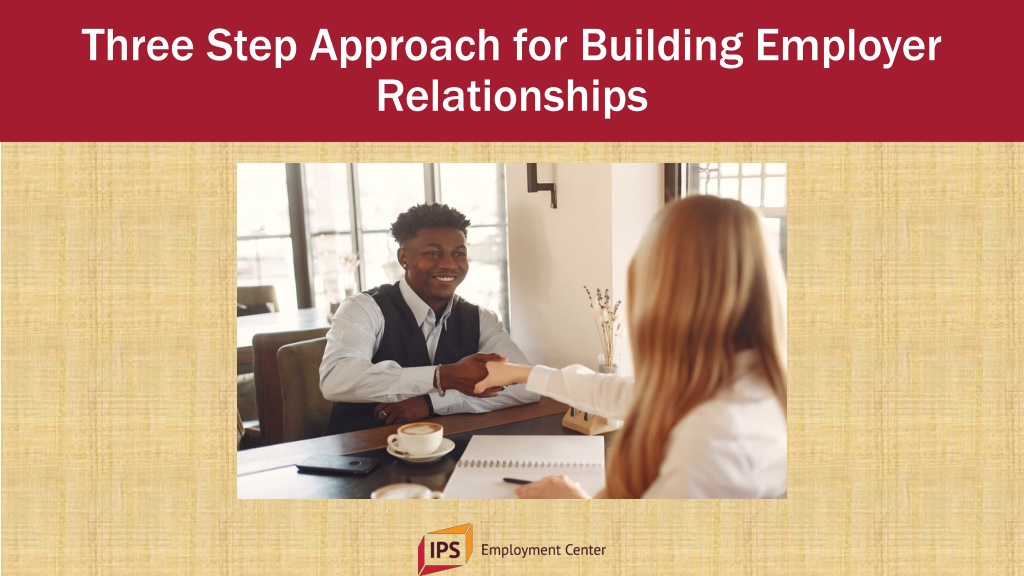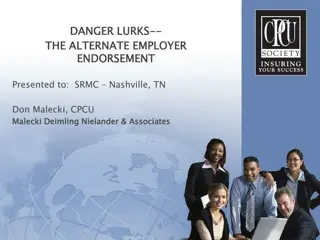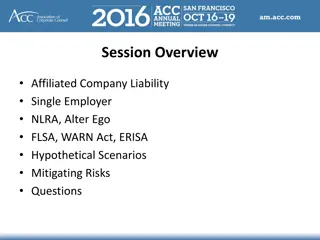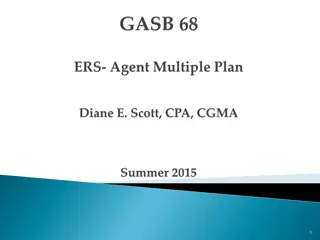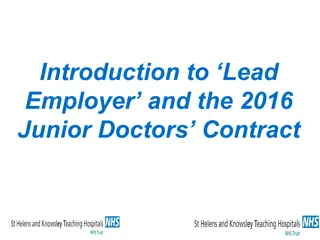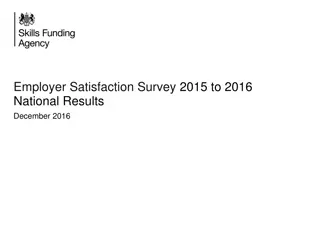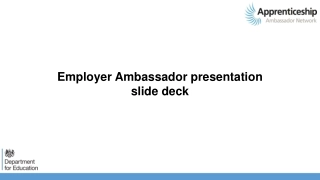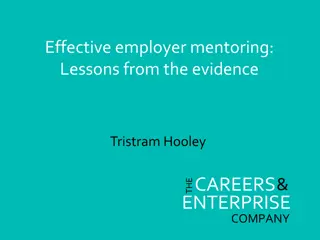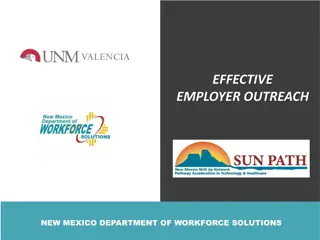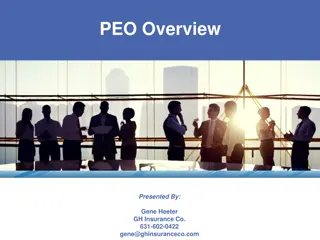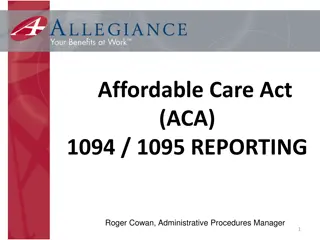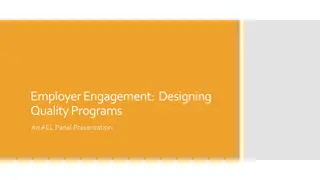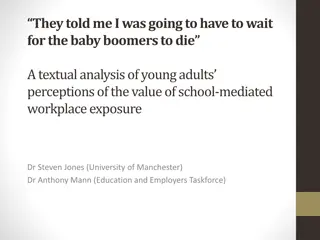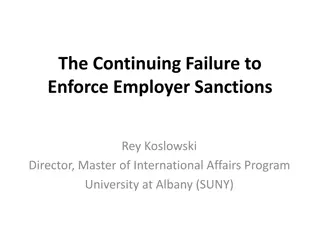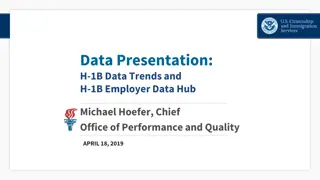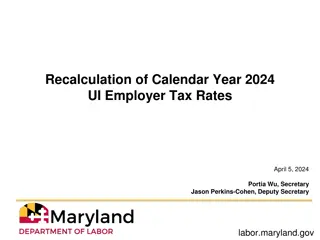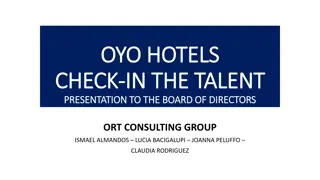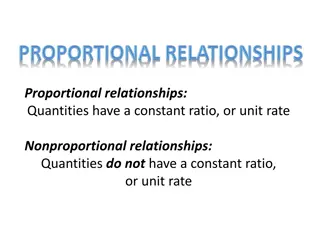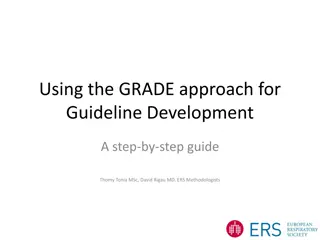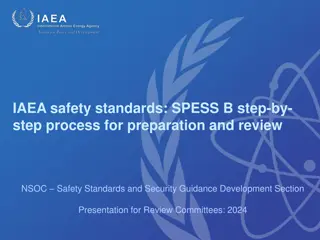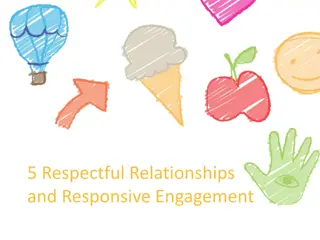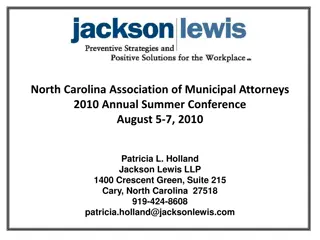Three-Step Approach for Building Employer Relationships
Learn a three-step approach for building strong relationships with employers: understanding their needs, acquiring knowledge of workplace culture, and matching job seekers effectively. Discover the value of scheduling meetings, creating value statements, and engaging with employers to find the right candidates for their businesses.
Download Presentation

Please find below an Image/Link to download the presentation.
The content on the website is provided AS IS for your information and personal use only. It may not be sold, licensed, or shared on other websites without obtaining consent from the author. Download presentation by click this link. If you encounter any issues during the download, it is possible that the publisher has removed the file from their server.
E N D
Presentation Transcript
Three Step Approach for Building Employer Relationships
Poll question #1 A good strategy for job development is to: 1. Visit employers to ask about openings. 2. Visit employers to present information on the IPS supported employment program. 3. Visit employers to learn about their businesses.
Review: Three cups of tea Learn about what is important to the employer Learn about the workplace culture Learn skills needed for different positions Benefits: Understand whether a position truly is a good match for the job seeker you know Demonstrate to the employer that you want to help her find the right workers for her business.
Review: Three cups of tea First cup of tea: Schedule an appointment Second cup of tea: Return to learn about the employer s business Third cup of tea: Discuss a job seeker who may be a good match for the employer s needs OR continue building the relationship
Value statement When asking for an appointment to learn about the business, consider why would an employer want to do it what s in it for her? Then explain it to the employer.
Value statement I am not looking for a job for anyone today. One of exiting parts of my job is to learn about the needs of employers and the type of job candidates they would like to meet in the future. "I help people who want to work find jobs that are the right match for their skills and personality. I'd love to meet with you for about 20 minutes in the next week or so to learn more about who is the right match for your business. I want to be sure that I only refer job seekers to your business if they are the type of workers you want to meet." If you are like most employers, you have learned about the type of person who is a good fit for your business. I want to know about the skills and personal characteristics of good employees at your business so that I can refer the type of person who will be a successful employee for you.
#1. How to Schedule a Meeting Writing an Introduction Statement Four Critical Elements Your name Your Employer What you do The purpose of your visit
Example Hello. My name is _______ (your name) and I work for Job Opportunities here in town. I m an employment specialist and my job is to introduce employers to people who want to work and have the skills those employers need. Part of my job is to learn about local businesses. I am not necessarily looking for a job for someone today but would like to schedule a 20-minute appointment with you to learn more about what you do here and the types of people who tend to be successful here.
Example Hello. My name is ______(your name) and I work for Mental Health Agency here in town. I m an employment specialist and I help people who have been out of work to re-engage in the workforce. Part of my job is to lean from employers about their businesses and hiring preferences. Would it be possible to schedule a 15-minute appointment to come back and lean more about_______(name of business)?
Your Introductory Statement ___________________________________________________________________ ___________________________________________________________________ ___________________________________________________________________ ___________________________________________________________________ ___________________________________________________________________ ___________________________________________________________________ ___________________________________________________________________ ___________________________________________________________________ ___________________________________________________________________
Step 2 Returning to learn about the employer s business Good questions to ask in order to learn about the business
Questions about the business: Why do you like working for ___________(name of business)? What are your goals for (business or department)? What sets your company apart from others? What other questions would you ask?
Good Questions To Learn About an Employer s Needs Questions about the right job candidate: What type of person tends to be successful here? What qualities do you look for when you are interviewing job candidates? What other questions would ask?
Good Questions To Learn About an Employer s Needs Questions about positions: Please describe your workforce. I see that you have ____positions. What other positions do you have that I may not know about? What is a typical day like for a _______(name position)? What other questions would ask?
Good Questions To Learn About an Employer s Needs Questions about the hiring process: What is your hiring process? So, people should start with an online application. But you mentioned that you need people who are self-starters with outgoing personalities. If you had a friend who matched that description how would you advise your friend to go about applying for work here? What other questions would you ask?
Ineffective questions Are you hiring? Do you anticipate job openings in the future? Do you hire people with criminal histories? Do you hire people who have a substance use disorders? What do you do here? (Learn this about the company before the appointment) Are you laying off?
The focus is to listen and try to understand the workplace from the employer s point of view. Be curious. Ask open- ended questions, use reflections, etc. You will know that the interview is going well if the employer is doing most the talking.
Video Good Galen
Questions about the workplace Questions about the type of person who would be a good fit Question about positions It s ok to stop here before asking questions about the hiring process
Top 5 Mistakes to Avoid During Meetings to Learn About an Employer 1. Asking about job openings 2. Interrupting the employer 3. Asking if the employer is open to hiring people with criminal histories 4. Speaking at length about your program 5. Neglecting to prepare for the meeting
After Meeting with the Employer 1. Write a thank-you note 2. Reflect on the stage of the relationship 3. Plan your next step
After Meeting with the Employer If the employer seems like they might be interested, but it looks like they will not be hiring anytime soon, they still may be able to help you by introducing you to other employers. For example, they might introduce you to some of their suppliers, or they may be willing to participate in a steering committee meeting to educate members about employer needs. Or they might be willing to help a client with a mock interview. These steps can help further your relationship with the employer.
After Meeting with the Employer If the employer appears interested in meeting people from your program now, or even at a later time when they expect to be hiring, return to talk about a person who might be a good fit for that business. John, I ve had time to consider your need to find people who are avid readers and would enjoy working with customers. I believe I do know someone similar to the person you described. Would you like to hear a little bit about her? If you know the employer is not hiring, ask if they would be open to allowing the candidate to visit the workplace to learn more about that type of position a 30- minute visit to observe workers and ask a few questions.
Step 3 Maintaining Employer Relationships Over Time What is the goal? What do you need to do, in order to be prepared?
Step 3 Maintaining Employer Relationships Over Time Stay in touch with the employer every four to six weeks. Each time the employer sees you again, it reinforces the notion that you are interested in a long-term relationship and that you are reliable you keep showing up! Further, don t rely on busy employers to remember to call you when they have a job opening. Visit regularly so that you will hear about openings before employers advertise those jobs.
Maintaining Employer Relationships Over Time Keep a list of 12-15 employers with whom you are building long-term relationships. Next to each employer, jot down the date of your most recent visit so that you can remember when you should return.
Examples of Ways to Maintain Employer Relationships Return to share good news about your program. For example, an article in the paper about your program or a record number of job starts in the last quarter. Return to let the employer know that you are working with someone who is interested in ___________work. Ask if the employer would be open to allowing the person to visit in order to observe and ask question about that type of positions. Ask for a tour of the business.
More Examples of Ways to Maintain Employer Relationships Return to share printed materials about your program, such as a brochure designed especially for employers Return to congratulate the employer about an article that you read about their business. Stop by to say hello and to ask the employer how business is going. Return to let the employer know that you do know a candidate who would be a good fit for the business. John, I know it s important to you to find employees who want to work here because they are interested in books, and also people who are friendly and outgoing. I do know someone who fits that description. Would you like to hear a little bit about her?
What Are Your Strategies to Sustain Employer Relationships?
Thank You Sandy Reese Sandra.reese@columbia.edu www.ipsworks.org This PowerPoint is to be used in conjunction with the Tips for Employer Relationships Building: A Guide for IPS Supported Employment Specialist booklet. Developed by: Sarah Swanson, Jerry Wood and Laura Flint.
